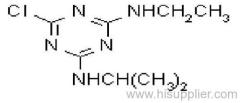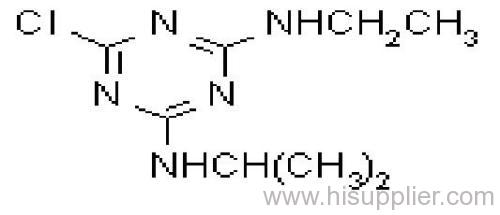Common name: atrazine
IUPAC name: 6-chloro-N2-ethyl-N4-isopropyl-1,3,5-triazine-2,4-diamine
Chemical Abstracts name: 6-chloro-N-ethyl-N'-(1-methylethyl)-1,3,5-triazine-2,4-diamine
CAS RN: [1912-24-9]
PHYSICAL CHEMISTRY
Composition: Tech. is 97% pure. Mol. wt.: 215.7; M.f.: C8H14ClN5; Form: Colourless powder. M.p.: 175.8 ºC; B.p.: 205.0 °C/101 kPa; V.p.: 3.85x10-2 mPa (25 ºC) (OECD 104). KOW: logP = 2.5 (25 ºC). Henry: 1.5x10-4 Pa m3 mol-1 (calc.) S.g./density: 1.23 (22 °C) Solubility: In water 33 mg/l (pH 7, 22 ºC). In ethyl acetate 24, acetone 31, dichloromethane 28, ethanol 15, toluene 4.0, n-hexane 0.11, n-octanol 8.7 (all in g/l, 25 ºC). Stability: Relatively stable in neutral, weakly acidic and weakly alkaline media. Rapidly hydrolysed to the hydroxy derivative in strong acids and alkalis, and at 70 ºC in neutral media; DT50 (pH 1) 9.5, (pH 5) 86, (pH 13) 5.0 d. pKa: 1.7, v. weak base.
APPLICATIONS
Biochemistry: Photosynthetic electron transport inhibitor at the photosystem II receptor site. Maize tolerance is attributed to rapid detoxification by glutathione transferases.
Mode of action: Selective systemic herbicide, absorbed principally through the roots, but also through the foliage, with translocation acropetally in the xylem and accumulation in the apical meristems and leaves.
Uses: Pre- and post-emergence control of annual broad-leaved weeds and annual grasses in maize, sorghum, sugar cane, pineapples, chemical fallow, grassland, macadamia nuts, conifers, industrial weed control. In Europe, use is concentrated in maize and sorghum. Used also in combinations with many other herbicides.
Phytotoxicity: Phytotoxic to many crops, including most vegetables, potatoes, soya beans, and peanuts.
Formulation types: FW; GR; SC; WG; WP.
MAMMALIAN TOXICOLOGY
Oral: Acute oral LD50 for rats 1869-3090 mg tech./kg, mice >1332-3992 mg/kg.
Skin and eye: Acute percutaneous LD50 for rats >3100 mg/kg. Mild skin irritant; non-irritating to eyes (rabbits). Skin sensitiser in guinea pigs, but not in humans.
Inhalation: LC50 (4 h) for rats >5.8 mg/l air.
NOEL: (2 y) for rats 10 mg/kg diet (0.5 mg/kg daily), for dogs 150 mg/kg diet (3.75 mg/kg daily), for mice 10 mg/kg diet (1.4 mg/kg daily).
ADI: 0.005 mg/kg b.w.
Toxicity class: WHO (a.i.) III (Table 5); EPA (formulation) III
EC hazard: (Xn; R48/22| R43| N; R50 R53)
ECOTOXICOLOGY
Birds: Acute oral LD50 varies from 940 mg/kg for bobwhite quail to >2000 mg/kg for mallard ducks and 4237 mg/kg for adult Japanese quail. Dietary LC50 (8 d) for Japanese quail (chicks) >5000, (adults) >1000 mg/kg.
Fish: LC50 (96 h) for rainbow trout 4.5-11.0, bluegill sunfish 16, carp 76, catfish 7.6, guppies 4.3 mg/l.
Daphnia: LC50 (24 h) 87 mg/l.
Algae: EC50 (72 h) for Scenedesmus subspicatus 0.043 mg/l, (96 h) for Selenastrum capricornutum 0.13 mg/l.
Bees: LD50 (oral) >97 ug/bee; (contact) >100 ug/bee.
Worms: LC50 (14 d) for Eisenia foetida 78 mg/kg soil.
ENVIRONMENTAL FATE
Animals: In mammals, following oral administration, atrazine is rapidly and completely metabolised, primarily by oxidative dealkylation of the amino groups, and by reaction of the chlorine atom with endogenous thiols. Diaminochlorotriazine is the main primary metabolite, which readily conjugates with glutathione. More than 50% of the dose is eliminated in the urine and around 33% in the faeces within 24 h.
Plants: In tolerant plants, atrazine is readily metabolised to hydroxyatrazine and amino acid conjugates, with further decomposition of hydroxyatrazine by degradation of the side-chains and hydrolysis of the resulting amino acids on the ring, together with evolution of CO2. In sensitive plants, unaltered atrazine accumulates, leading to chlorosis and death.
Soil/Environment: Major metabolites under all conditions are desethylatrazine and hydroxyatrazine. Field DT50 16-77 d (median 41 d), the longer values being from cold or dry conditions. In natural waters, DT50 10-105 d (mean 55 d). DT50 under groundwater conditions 105->200 d, depending on test system. Kd 0.2-18 ml/g, Koc 39-173 ml/g; desalkylated metabolites had values similar to those of atrazine, while hydroxyatrazine was much more strongly adsorbed.



.jpg)



.gif)





